The X-Pro1 is Fujifilm's premium entry into the mirrorless camera segment, the announcement of which comes alongside the release of three fast aperture prime lenses. For a camera that costs Rs. 1,04,999, we'd have expected better focus performance (with respect to tracking and acquisition). While the sensor performance in terms of image quality and sharpness is stellar, we have a hard time justifying the high price just for the sensor and the resemblance to the age old Rangefinders. However, if you're the kind of person who can afford something this expensive and believe that there is no price for nostalgia, then the X-Pro1 might be the camera for you.
While the X-10 and the X-100 were Fujifilm’s candidates in the prosumer point-and-shoot segment, the X-Pro is Fujifilm’s contestant for the mirrorless ILS cameras. The X-Pro1 packs Fujifilm’s innovative sensor technology, along with garnering the support of three large aperture prime lenses; the 18mm f/2.0, the 35mm f/1.4 and the 60mm f/2.4 macro. Fujifilm’s innovation, packaged into a camera that evokes strong emotional responses, costs a whopping Rs. 1,04,999, so the obvious question is, is it worth it? We take this bad boy for a ride around town and see how it feels and functions.
Build & Ergonomics
If you’re the kind of photographer who grew up in the 80s or early 90s, you’d know what a Rangefinder is. Those funky things had their viewfinder to the left of the camera, and when you looked through it, you knew your photo wasn’t going to be exactly like what you saw in the viewfinder (due to the slight shift in what the lens sees and what the VF sees). Using a Rangefinder required exceptional skill and vision, and was hence often considered a benchmark for skill.
The X-Pro1 looks just like an old school Rangefinder complete with the offset viewfinder, the textured leathery layer and a host of dials to aid manual shooting. The camera is built solidly thanks to its magnesium alloy construction and is great to hold. If it wasn’t for the glorious 3-inch 1.2M dot LCD on the back, there would be no way to distinguish this from an analog Rangefinder.
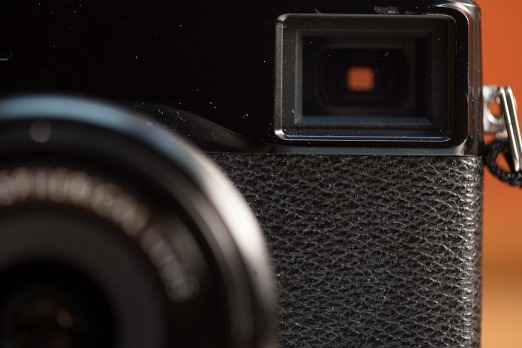 |
 |
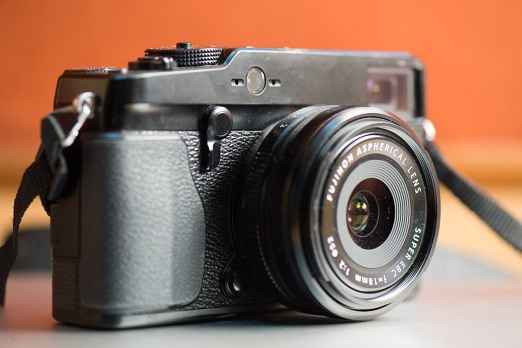 |
 |
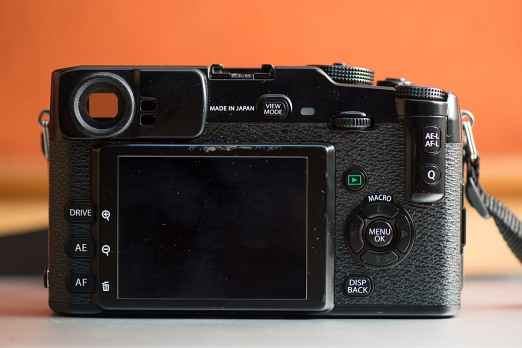 |
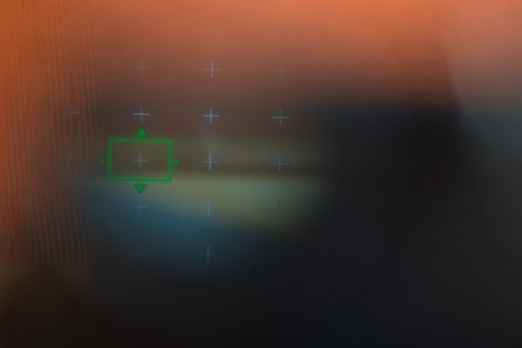 |
 |
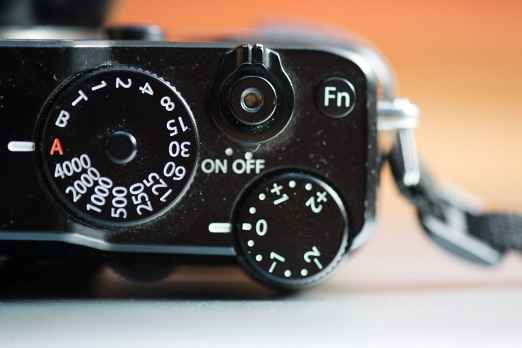 |
 |
The buttons are another giveaway of the X-Pro1’s digital nature. Buttons with various dedicated features such as changing focus points, shooting mode, navigation buttons, menu button etc., are neatly arranged on the back. The buttons feel well built and are easy to press. What we liked a lot was the “view mode” button on top (next to the viewfinder) which allowed us to switch from LCD display (live view shooting) to the viewfinder.
Not really an ergonomic feature, but the camera strap that comes bundled with the X-Pro1 feels really premium and letting the camera hang across our shoulders using the strap was absolutely effortless.
Features & Specifications
The X-Pro1 is built on Fujifilm’s revolutionary 16 megapixel APS-C X-Trans sensor. A conventional imaging sensor uses the Bayer-pattern (which puts only two colours per row) colour filter arrays that is used in conventional cameras. The way this resolves colour information leads to moiré and other artefacts being introduced into the image, to counter which, camera makers introduced the anti-aliasing filter which causes the image to become soft. Fujifilm’s X-Trans sensor places three colours per pixel row, in no particular order, which does away with the moiré, and hence the need for an anti-aliasing filter. The result, according to Fujifilm, is sharper images and we can definitely vouch for that fact. We’re yet to see images shot at f/2.0 look as sharp as they do coming out of the X-Pro1.
The X-Pro1 also features a completely new lens mount, an all-electronic “X-mount”. There are a few surprises packed away into this new mount, the first being the lenses that attach to it. Each of the three lenses launches with the X-Pro1 feature a manual dial for changing aperture. Interestingly, turning the ring doesn’t actually change the aperture (physically inside the lens), but the signal is conveyed electronically through the 10-pin connector built into the lens mount.
The new mount is also designed to have the least amount of flange distance amongst all lens mounts, meaning that the lens element can be placed closer to the sensor. Coupled with the large back element of the Fujifilm lenses, the fast aperture primes are able to provide better illumination to the edges, meaning the edges in the images are not only evenly lit, but also sharp.
The X-Pro1 comes with an electronic viewfinder which essentially mirrors the LCD at the back. At first, we observed that looking through the viewfinder yielded a “corrected” view of the image, meaning, we were seeing a digital rendition. Not seeing a part of the lens in the viewfinder meant that we weren’t actually looking through it, which left us a little disappointed. However, an hour later with the menu, we discovered that the EVF could be altered to display a true “through the viewfinder” experience, while drawing a square overlay on the area that would be recorded in the final image. This, we loved. It would be sad to see a camera, priced so high due to its resemblance with technology past, not have the one thing that set Rangefinders apart from other cameras.
Speaking of lenses, the X-Pro1 features a nifty little switch at the bottom (next to the lens mount) that allows switching the focus from manual to single shot, or continuous tracking. This is a nice touch that lends itself well to the classic feel of the camera.
Image Quality
The X-Pro1 features a sensor the size of DSLR cameras (crop factor of 1.5) and is designed using an unconventional technique. According to Fujifilm, the random placement of the colour pixel on the 6×6 grid allows the sensor to simulate the film effects well. Not only that, but the sensor is also said to perform at par, or better than the regular APS-C sensors. We do not take such claims lightly and consider it our solemn duty to test them out.
First up, we tested the X-Pro1 outdoors with the 18mm f/2.0 lens mounted on it (it’s the only one we received with our review unit). We shot with the camera for over 5 days extensively, and noticed that the camera seemed to consistently underexpose. We figured that this was due to the wide angle nature of the lens (especially in scenes where the sky was involved) and dialled in the appropriate exposure compensation using the dial on top (by far our most favourite feature!). However, once the exposure was locked in place, the quality of the images was self-evident.
 |
 |
 |
 |
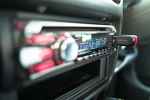 |
 |
 |
 |
 |
 |
The X-Pro1 has the capability of emulating Fujifilm’s Provia, Velvia and Astia films, along with being able to bracket between the various effects. We chose to shoot most of our shots on the Provia preset as its most natural looking of the three. We found the colours to be very natural indeed. For example, shooting a close-up of a leaf which was an unconventional shade of green, we found that the image to reflected the green in the same light. It didn’t look washed out, nor did the camera over-saturate the colours. We kept the white balance on auto to see how it would handle the real world conditions and as far as we go, it handles the task pretty damn well (outdoors at least). Speaking of white balance, we found that when shooting in places like malls or coffee shops that usually employ a mix of fluorescent and incandescent lights (malls may even use halogens or mercury vapor lamps), the images were extremely warm and underexposed by about a third of a stop. However, if you’re shooting RAW, this isn’t something to really worry about as it can easily be fixed in post-production. This isn’t particularly strange behavior on the part of the X-Pro1 as most cameras do tend to expose the images a tad too warm in such environments.
One area of performance where the X-Pro1 had us impressed was its dynamic range. We shot scenes in the worst of lightings (such as shooting a building in the mid-day sun) or an object under shade with the sun behind it. We noted that the X-Pro1 managed to retain an impressive amount of detail in both the shadows and the highlights area. This is definitely one area where the X-Pro1 shines.
 |
 |
Real world results left us as happy campers, but we couldn’t wait to test out that X-Trans sensor. Hence, we headed into the studio and shot our standard test target to see how the new sensor would handle noise. We fired off the camera at the standard ISO 200 through 6400 (the X-Pro1 can shoot up to ISO 25,600, but only in JPG mode. We chose to test only the RAW supported ISO). Up until ISO 3200, the lack of noise and retention of detail had us quite satisfied. At ISO 6400, we started to notice an excessive amount of luminance noise, while chrominance noise was still barely there. We are generally used to a pleasing level of fine chrominance noise while testing, but the X-Pro1 yielded rather unpleasantly large chunks of chrominance noise that definitely cannot be chalked up to the “film-grain” category. However, noise did not mean a loss of detail. The image was still usable, if put through some noise reduction processing.
|
ISO 200
|
ISO 400
|
ISO 800
|
|
ISO 1600
|
ISO 3200
|
ISO 6400
|
|
Base shot
|
||
Verdict
Rs. 1,04,999. That’s how much the X-Pro1 costs, without a lens. Let that sink in for a bit. Clearly this isn’t a mirrorless meant for the average user, given not only its price, but its design as well. This isn’t meant to match DSLRs that cost as much, but instead, consider it more like a “luxury” camera that definitely delivers on the promise of performance.
The X-Pro1’s focus is an average performance in terms of speed, but effective even in low light thanks to the bright AF illuminator on the front. The fast aperture primes with their incredible sharp images are definitely bound to attract the niche photographer. With Fujifilm just announcing the availability of the 18-55 f/2.8-4.0 IOS zoom lens for the system (with more zoom lenses on the way for 2013), the X-Pro1’s popularity is definitely bound to increase, but again, only in niche circles.
There is no doubt that the innovation and science that has gone into developing the X-Pro1 delivers on every account. The novel sensor design allows the anti-aliasing filter to be discarded, yielding sharper images. The Rangefinder design works with the classic optical viewfinder as well as in EVF mode.
The premium price could be said to be justified on the grounds of the X-Pro1’s resemblance to an era that was a high-point in unconventional/artistic photography. Not to mention, the X-Pro1 isn’t all that expensive if you compare it to a Leica, making it a solid alternative.
Swapnil Mathur
Swapnil was Digit's resident camera nerd, (un)official product photographer and the Reviews Editor. Swapnil has moved-on to newer challenges. For any communication related to his stories, please mail us using the email id given here. View Full Profile











